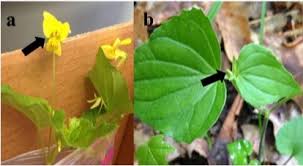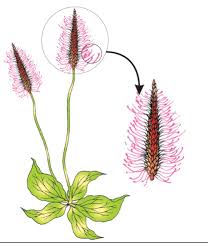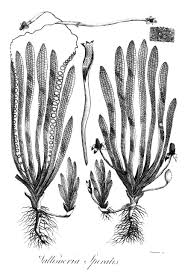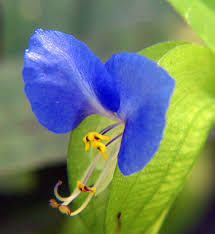In flowering plants, male and female gametes are non-motile, therefore, they have to be brought together for fertilization. The transfer of pollen grains to stigma is called pollination.
Pollination types:-
Depending on the source of pollen, pollination is of three types:-
- Autogamy:- The transfer of pollen grain from the anther to the stigma of the same flower.

Adaptations seen in plant to ensure self- pollination:-
(i) Bisexuality:- Presence of both the essential whorls in the same flower.
(ii) Homogamy:– Maturation of both androecium and at the same time, i.e there should be synchrony in release of pollen and stigma maturation.
(iii) Cleistogamy:- A condition in which flower does not open. In such flowers, the anthers and stigma lie close to each other. When anther dehisce in the flower buds, pollen grains come in contact with stigma to effect pollination.
Some plants like Viola (common pansy), Oxalis and Commelina produce both types of flowers i.e open flowers (chasmogamous) and closed flowers (cleistogamous).
(a) It ensures seed formation even in the absence of any pollination agent.
(b) It is cheaper for the plant as there is no costly nectar or fragrance which the plant has to produce for pollination
Disadvantage of Cleistogamy:- The offsprings produced have limited genetic diversity.
(iv) Bud pollination:- When self pollination occurs in the bud stage before the opening of flowers, e.g Pea and Rice.
- Geitonogamy:- The transfer of pollen grains from anther to the stigma of another flower of the same plant. This transfer involves an agent of pollination, hence functionally it is cross-pollination. Genetically, it is similar to autogamy since the pollen grains come from the same plant.
- Xenogamy:- The transfer of pollen grains fron anther to the stigma of another flower of different plant of the same species.

This is the only type of pollination which brings genetically different types of pollen grains to stigma.
Agents of pollination
_________|_____________________
| |
Abiotic agents (Wind,Water) Biotic agents (Animals)
(Used only by a small proportion of plants) (Used by majority of plants)
(1) Wind (Anemophily):- This is the more common amongst abiotic pollinations.
Characteristics of wind pollinated flowers:-
(i) The pollen grains are light and non-sticky.
(ii) The flowers have well-exposed stamens.
(iii) Flowers have large feathery stigma to easily trap the air borne pollen grains.
(iv) Nectaries absents.
(v) Presence of single ovule in each ovary.
(vi) Flowers packed into inflorescence.
Examples It is quite common in grasses.
(i) Maize
(ii) Wheat
(iii) Sugarcane
(iv) Bamboo
(2) Water (Hydrophily):- Pollination by water is quite rare in flowering plants and is limited to about 30 genera, mostly monocots, e.g ; Fresh water plants like Vallisneria, Hydrilla, marine water plant like Zostera.

(i) Light, unwettable pollen grains, Generally, surrounded by mucilaginous covering, hence protected from wetting.
(ii) Long, sticky unwettable stigma.
Pollination by water may occur at two places:-
(a) On the surface of water (Epihydrophily): Example: Vallisaneria.
- The female flower have a very long pedicel, therefore it reaches the surface of water.
- Male flowers after breakage floats on the surfaces of water.
- Pollen grains are released on to the surface of water. They are carried passively by water currents, some of them eventually reach the flowers and the stigma.
(ii) Beneath the surfaces of the water (hydrophily) : Example: Zostera (sea green)
Zostera is a marine water plant. Female flowers remain submerged in water. Pollen grains are long ribbon like and they are carried passively inside the water, some of them reach the stigma and achieve pollination.
In a majortityof equatic plants, the flowers emerge above the level of water and are pollinated by insects or winds. E.g., water hyacinth and water lily are pollinated by insects.
Flowers pollinated by aboitic agents are not very colorful and do not produce nectar because the bright colours of the flowers are to attract insects to pollinate them and the nectar they give is a reward for the pollinator. Pollen grains coming in contact with stigma is a chance factor in both wind and water pollination.
. To compensate for these uncertainties and associated loss of pollen grains, the flowers produce enormous amount of pollen when compared to the number of ovules available for pollination.
